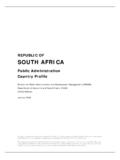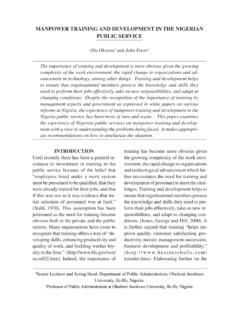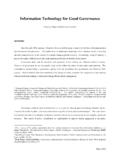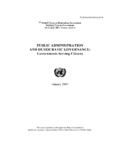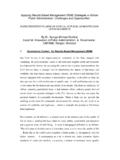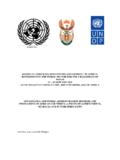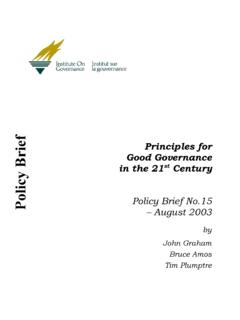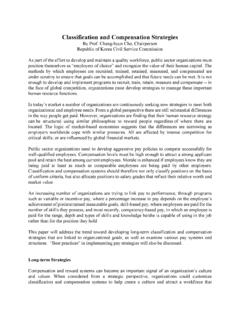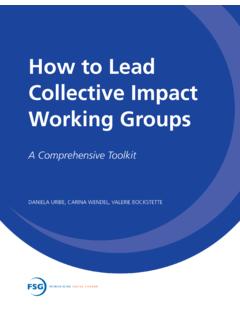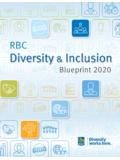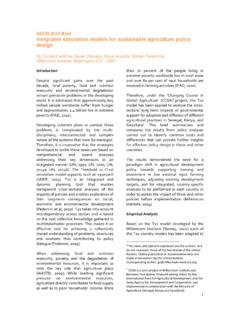Transcription of Theories of Governance and New Public Management
1 Theories of Governance and New Public Management : Links to Understanding Welfare Policy Implementation Jo Ann G. Ewalt Department of Government Eastern Kentucky University Prepared for presentation at the Annual conference of the American Society for Public Administration Newark, NJ March 12, 2001 SECOND DRAFT COMMENTS WELCOME Note: This paper sketches out a research design, but it does not include analysis of data. Unfortunately, data were not available in time for the ASPA conference. Introduction If Max Weber and Woodrow Wilson were to suddenly appear on the landscape of modern Public administration, normative Theories in hand, it is likely they would be unable to recognize the field. The comprehensive, functionally uniform, hierarchical organizations governed by strong leaders who are democratically responsible and staffed by neutrally competent civil servants who deliver services to citizens (Ostrom, 1973) to the extent they ever existed are long gone.
2 They have been replaced by an organizational society in which many important services are provided through multiorganizational programs. These programs are essentially interconnected clusters of firms, governments, and associations which come together within the framework of these programs (Hjern and Porter, 1981, pp. 212-213). These implementation structures operate within a notion of Governance about which a surprising level of consensus has been reached. There is a pervasive, shared, global perception of Governance as a topic far broader than government ; the Governance approach is seen as a new process of governing, or a changed condition of ordered rule; or the new method by which society is governed (Stoker, 1998, p. 17). Similarly, in the scholarship that has followed the Reinventing Government themes of Public effectiveness, much has been written of New Public Management practices by which Governance theory is put into action (Mathiasen, 1996; Lynn, 1996, 1998; Terry, 1998; Kelly, 1998; Peters and Pierre, 1998).
3 In this complex, devolved mode of service delivery, the unit of analysis for some students of policy implementation is the network of nonprofit organizations, private firms and governments. As Milward and Provan note, in policy arenas such as health, mental health, and welfare, "..joint production and having several degrees of separation between the source and the 2 user of government to ensure that hierarchies and markets will not work and that networks are the only alternative for collective action" (2000, p. 243). The purpose of this paper is to attempt to set forth a theoretical framework for the study of welfare policy implementation by synthesizing the related and theoretically consistent concepts of Governance , New Public Management , and networks.
4 I then discuss how this framework can be applied to welfare policy implementation. I follow the lead of scholars who have attempted to offer coherence and synthesis to a research field that historically has been dominated by top-down and bottom-up perspectives. The need to inform implementation scholarship is great. As O Toole concludes in his review of the literature on multiorganization policy implementation, The field is complex, without much cumulation or convergence. Few well-developed recommendations have been put forward by researchers, and a number of proposals are reasons for the lack of development are analyzed: normative disagreements and the state of the field s empirical theory. Yet there remains numerous possibilities for increasing the quality of the latter.
5 Efforts in this direction are a necessary condition of further practical advance. (1986, p. 181). Welfare Policy Implementation It would be difficult to find a policy arena in which the sheer number of local, regional, and state organizations involved in the implementation of programs and policies was greater, and in which the organizational interdependencies and dynamics were more varied. The complexity of welfare policy structures, as well as the variation in these structures, is due in large part to the flexibility given to states by the Personal Responsibility and Work Opportunity Reconciliation Act of 1996 (PRWORA). Before PRWORA, welfare policy generally referred to the Aid to Families with Dependent Children (AFDC) program, which had been in place for sixty years.
6 Under the 3 reformed welfare system, AFDC has been replaced with the Temporary Assistance for Needy Families (TANF) program. The legislation ends federal entitlements, funds welfare through capped block grants to the states, and sets a five-year maximum lifetime limit on receipt of welfare benefits. Perhaps as important as these policy changes, PRWORA gives the states enormous latitude in setting eligibility, benefit, and sanction policy, and it changes the focus of welfare from a human capital model emphasizing prolonged education and vocational training to a work-first approach that stresses the importance of work and self-sufficiency (Hayward, 1998). While there are many models of welfare implementation, welfare is essentially administered at either the state level (centralized administration) or at the local or county level (decentralized administration).
7 Regardless of the administration status, PRWORA has brought together Public , nonprofit, and private agencies that had been largely autonomous in their operations and more narrowly focused in their organizational mission. For example, in theory, Private Industry Councils (PICs) and Departments of Employment Services (DES) were to have been working closely with welfare agencies implementing the Job Opportunity and Basic Skills Program (JOBS) in the late 1980s and the first half of the1990s. The reality was that for most states, there was very little involvement from employment-related Public agencies in implementing welfare programs (Ewalt, 1998). In the current environment, local welfare implementation involves a host of Public and nonprofit organizations.
8 Regardless of whether the organization is centralized or decentralized, a variety of agencies are contracted with to provide basic services such as eligibility assessment, needs assessments, job training, employment training, education, transportation, child care, job retention, and rehabilitation. In addition, although most welfare recipients are children and their mothers, non-custodial parents (usually fathers) are also an important if ancillary program target. 4 Important goals of welfare programs relate directly to the legislation, and to state implementing regulations. All states are subject to statutory requirements about the percent of welfare clients who must be engaged in "countable" work activities, among other rules, and these requirements drive many of the organizational relationships states and localities establish.
9 The bottom line for state and local welfare programs is that they seek to accomplish the following universal goals: =Divert potential clients from TANF when other assistance may be more appropriate; =Move TANF clients into countable work activities as soon as possible and at least as soon as prescribed by state and/or federal law; =Meet federally mandated work participation rates; =Remove barriers such as lack of child care, transportation, appropriate clothing, and so on, so TANF clients can remain at work; =Assist TANF clients in devising a self-sufficiency plan to move off Public assistance; and =Apply client sanctions when noncompliance with program rules reaches a critical level. This brief review of welfare policy is intended to introduce the requirements of welfare reform and its implications for organizational structure.
10 To describe the specific nature of welfare implementation arrangements, we turn to the literature on networks. Networks in Action In meeting program goals, welfare agencies must establish both informal and formal relationships with numerous organizations (Provan and Milward, 1995; O'Toole, 1997; Agranoff and McGuire, 1998). In many of these multiorganizational networks of linked agencies and other units, the linkages are not particularly well established. Rather, they are in a state of continual reformulation because of shifts in providers, new program emphasis or problems, or other internal or external shocks to the environment (O'Toole and Meier, 2000). The practice of contracting out government services to networks of nonprofit (and some private) organizations has been referred to as the "hollow state" (Milward and Provan, 2000).

